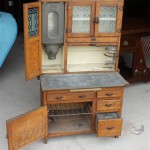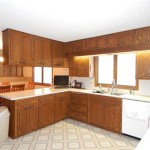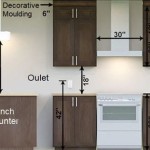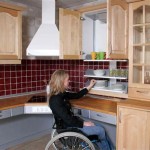```html
How To Hang Cabinets In A Mobile Home
Hanging cabinets in a mobile home presents unique challenges compared to traditional construction. Mobile home walls are typically thinner and framed differently, requiring specific techniques and hardware to ensure secure and lasting installations. Failure to adhere to proper procedures can result in cabinet failure, wall damage, and potential safety hazards. This article provides a detailed guide on how to successfully hang cabinets in a mobile home.
Before commencing any work, it is crucial to understand the specific construction of the mobile home walls. Typically, they consist of thin studs (often 1x2 or 1x3 lumber) spaced further apart than standard 16-inch centers found in conventional homes. These studs are often wrapped with paneling or drywall. The underlying framing may be of different materials, ranging from traditional wood to metal. Identifying the stud locations and their composition is paramount for proper cabinet mounting.
Safety is paramount. Before drilling or cutting, ensure that there are no electrical wires or plumbing lines within the walls. A stud finder with AC wire detection can be a valuable tool. Turn off the power to the area where the cabinets will be installed as a precaution. Wear safety glasses to protect your eyes from dust and debris. Use appropriate personal protective equipment (PPE) such as gloves when handling materials and tools.
Key Point 1: Identifying Stud Locations and Wall Composition
Accurate stud identification is the foundation of a secure cabinet installation. A standard stud finder represents the initial step in this process. However, given the construction variations in mobile homes, relying solely on a standard stud finder might prove inadequate. Mobile home studs may be spaced irregularly or constructed of metal which may not be detectable using typical stud finders designed for wood studs. Therefore, supplementing the stud finder with manual methods is highly advisable.
One such method involves using a finish nail or small drill bit to probe for studs. Gently insert the nail or drill bit into the wall at different points, a few inches apart, along the prospective cabinet mounting area. Resistance will indicate the presence of a stud. Ensure to patch any resulting holes after confirming stud location to prevent moisture intrusion and maintain aesthetic appeal. Mark the stud locations clearly with a pencil or marker.
Determining the wall composition is also crucial. Knowing whether the walls are drywall, paneling, or another material dictates the appropriate type of fasteners to use. Paneling, for example, requires fasteners that can grip the thinner material effectively. If there's uncertainty about the wall composition, removing a small section behind the existing cabinets or in an inconspicuous location can reveal the layering and material type.
Furthermore, inspect the condition of the studs. Look for signs of water damage, rot, or insect infestation. If any of these issues are present, the studs must be repaired or replaced before proceeding with the cabinet installation. Weak or damaged studs won't provide sufficient support for the cabinets, leading to potential failure.
Key Point 2: Choosing the Right Fasteners and Mounting Techniques
The selection of appropriate fasteners is critically important for the long-term stability of the mounted cabinets. Standard wood screws are often inadequate for mobile home construction, especially when dealing with thin studs or paneling. Consider using specialized fasteners designed for mobile home applications. These fasteners often feature wider threads and greater holding power.
Cabinet screws, which are longer and stronger than standard wood screws, offer enhanced holding ability, particularly when anchoring into wood studs. Self-tapping screws, capable of creating their own threads, are beneficial when securing cabinets to metal studs. Toggle bolts, used in conjunction with through-holes in the wall, are particularly effective when anchoring cabinets to hollow walls, distributing the weight across a larger area. However, using toggle bolts requires careful planning to ensure proper placement and alignment.
In addition to fasteners, consider using construction adhesive. Apply a bead of construction adhesive to the back of the cabinet where it contacts the wall. This adds significant strength and stability to the installation by bonding the cabinet directly to the wall surface. Ensure to use an adhesive specifically designed for the wall material. Clamping the cabinets securely while the adhesive cures is essential for optimal bond strength.
For heavier cabinets, such as those containing dishes or appliances, reinforcement may be necessary. Reinforcing the studs with additional lumber, or using metal backing plates behind the wall, can provide added support. This is particularly important if the existing studs are undersized or show signs of weakness. Properly distributing the weight of the cabinets ensures a safe and secure installation.
Key Point 3: Implementing Proper Installation Procedures
Precise measurements and level installation are essential for achieving a professional and functional cabinet installation. Ensure the cabinets are level both horizontally and vertically. Using a laser level or a traditional bubble level is crucial to achieving accurate alignment. Shims can be used to compensate for any unevenness in the walls or floors.
Before hanging the cabinets, pre-drill pilot holes through the cabinet backs, aligning them with the identified stud locations. This prevents the wood from splitting when driving in the screws. The pilot holes should be slightly smaller than the diameter of the screws being used. Ensure that the pilot holes are drilled straight and true to maintain proper alignment.
When installing multiple cabinets, start with the upper cabinets. Securely attach a ledger board, a temporary support, to the wall at the desired height of the bottom edge of the upper cabinets. This provides a stable platform to rest the cabinets on while attaching them to the wall. The ledger board should be level and securely fastened to the studs. Leave sufficient space between upper and lower cabinets, usually 18 inches, to accommodate countertop appliances.
After hanging the upper cabinets, proceed with the lower cabinets. Ensure the floor is level before installing the lower cabinets. Shim the cabinets as needed to achieve a perfectly level surface. Secure the lower cabinets to the wall studs using appropriate fasteners. Connect the lower cabinets to each other using screws or cabinet connectors. This strengthens the overall structure and ensures uniform support. Verify that the cabinet doors and drawers align properly and operate smoothly.
Once cabinets are hung, carefully inspect around edges of cabinets for gaps. Seal cabinet edges where they meet the wall with caulk to prevent moisture incursion and vermin entry. Conceal fastener holes with wood putty or appropriate fillers, sanding flush once dry. Apply touch-up paint or stain to match the surrounding finish. Installation of the cabinet doors and hardware finalizes the installation. Double-check all fasteners for tightness and alignment for long-lasting functionality.
```
Mobile Home Kitchen Cabinets The Do S And Don Ts Mhvillager

How We Made It Easy To Put Up Cabinets Mobile Home Renovation 32

Double Wide Mobile Home Kitchen Cabinets Rocky Hedge Farm

Installing Kitchen Cabinets Into Your Mobile Home

Double Wide Mobile Home Kitchen Cabinets Rocky Hedge Farm

Installing New Kitchen Cabinets In A Mobile Home Living

How To Take Cabinets Off The Wall In A Mobile Home Hometalk

Double Wide Mobile Home Kitchen Cabinets Rocky Hedge Farm

Double Wide Mobile Home Kitchen Cabinets Rocky Hedge Farm

Mobile Home Kitchen Cabinets The Do S And Don Ts Mhvillager
Related Posts








